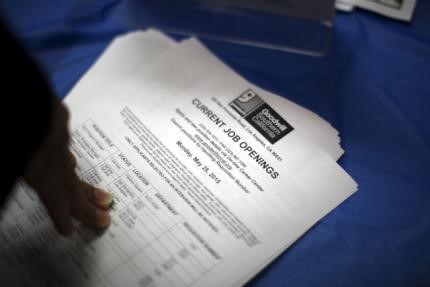
Investing.com — U.S. jobless claims data are set to grab the headlines again, with the number of new claims expected to edge down to 5.1 million. Stocks are set to open higher after President Donald Trump says he’ll issue new guidelines for reopening the U.S. economy in the afternoon. The U.K. and Japan extend their lockdown measures, while the pace of continental European reopening picks up. And oil prices rebound from the $20 level ahead of OPEC’s monthly report. Here’s what you need to know in financial markets on Thursday, April 16th.
1. Jobless claims expected to ease a little
Are you ready?
Another 5.1 million Americans are expected to have filed initial claims for unemployment benefits last week, down from 6.65 million the week before. Ongoing claims are expected to rise to 13.5 million from 7.46 million a week earlier, according to analysts polled by Investing.com.
The numbers are due out at 8:30 AM ET (1230 GMT).
Wednesday saw the biggest-ever monthly drop in U.S. retail sales and the sharpest fall in industrial production since 1946, as lockdowns to contain the spread of the Covid-19 virus took effect across the country.
2. Trump to issue new guidelines on reopening the U.S. economy
President Donald Trump said he will issue new guidelines for reopening the economy later Thursday, saying that “the data suggests that, nationwide, we have passed the peak on new cases.”
He pointed to declines in new cases in New York city and New Orleans, while the growth of new cases in Detroit and Denver has flattened out. Trump also noted “progress” in Washington DC, Baltimore and St. Louis.
“New U.S. cases per million will soon be at the levels which prompted easing lockdowns in Italy, Spain and Austria, said Pantheon Macroeconomics chief economist Ian Shepherdson.
Meanwhile, The Wall Street Journal reported that business leaders had urged Trump on a conference call not to hurry the reopening of the economy, saying that people will need much greater access to testing before they have confidence to resume normal patterns of working and socializing.
3. Stocks set to open higher; Morgan Stanley (NYSE:MS) earnings due
U.S. stocks are set to open cautiously higher in response to Trump’s comments after falling on Wednesday in reaction to the drops in retail sales and industrial output.
By 6:35 AM ET (1035 GMT), the Dow Jones 30 Futures contract was up 115 points or 0.5%, while the S&P 500 Futures was up 0.7% and the Nasdaq 100 Futures contract was up 1.0%. Morgan Stanley is set to round off a bank earning season characterized by $25 billion in loan-loss provisions but some stellar numbers for trading revenue.
Havens remain in demand: the dollar index was consolidating above 100 after the U.S. data triggered a fresh bout of safe haven buying of the world’s reserve currency. Treasury bond yields were mostly unchanged after sharp falls on Wednesday. Gold futures were steady above $1,750 an ounce.
4. U.K. extends lockdown as Germany flags gradual reopening
Sterling slipped and U.K. stocks underperformed, as the U.K. extended its lockdown measures for another three weeks.
Meanwhile, Japan extended its state of emergency to nationwide status in response to stubborn increases in new cases across the country. Emergency measures had previously been restricted to Tokyo and a couple of other metropolitan areas.
Germany registered its highest rate of new infections in five days, although daily calculations everywhere have been vulnerable to distortion over the Easter week. Europe’s largest economy on Wednesday said it will reopen smaller shops and all auto dealerships from next week, and intends to partially reopen its schools from May 3rd. Large-scale public events and gatherings will, however, remain banned until the end of August.
5. Oil prices rebound; OPEC report eyed
Crude oil prices rebounded again from the $20 level as traders attempted to guess the pain threshold of key producers.
Goldman Sachs (NYSE:GS) analysts have argued that anything below $20/bbl is below the cash costs threshold of many producers and thus unlikely to last for long. However, the near-term glut remains acute, with physical cargoes of Russian Urals blend reportedly being quoted at $14 a barrel on Thursday.
Bloomberg reported overnight that the U.S. administration is examining the possibility of paying oil companies not to produce oil. However, that is likely to be blocked by a Democrat-dominated House of Representatives who blocked provisions to spend $3 billion filling the Strategic Petroleum Reserve last month.
The Organization of Petroleum Exporting Countries is due to release its monthly oil market report at 7 AM ET, although its forecasts – at least on supply – are likely to tally closely with the calculations that were behind last weekend’s output cut deal.
By 6:35 AM, U.S. crude futures were up 1.8% at $20.23 a barrel, while Brent was up 3.0% at $28.52 a barrel.



